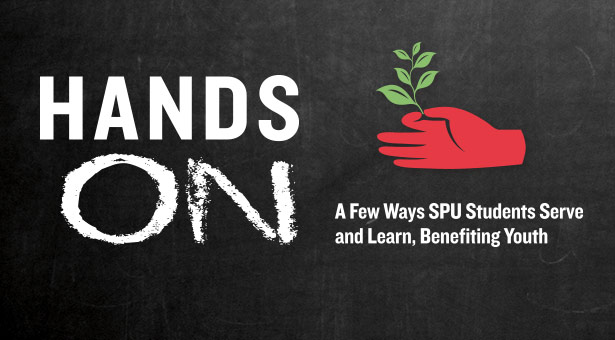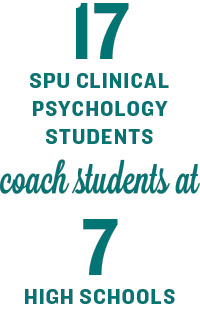
Infographic Design by BeckyJo Bourgeois
In seminars led by faculty, students, and community organizations, this year’s Day of Common Learning highlighted the ways Seattle Pacific University is working to benefit youth.
“We are training students to be aware of public–private partnerships,” says Margaret Diddams, director of the Center for Scholarship and Faculty Development, which organizes the event.
Here are some examples of ways that SPU students leverage their own learning to support young people:
![]()
Encouraging Youth to Plan for College
Kids Going to College
Nearly 400 SPU students (and more than 2 dozen faculty and staff) have hosted elementary school students on campus over the past 10 years. They act as teaching assistants and tour guides for individuals and small groups of visitors. They encourage youth to stay in school and plan for college.
Program goals:
- Help youth in underserved communities to envision themselves as university students.
- Help SPU students develop cultural awareness, understanding, and sensitivity through experience with diverse communities.
- Prepare SPU education students to be effective teachers.

<< 1,820 people have been involved in these programs over the last decade.
SPU Faculty/Staff
SPU Students
Kindergartners
3rd Graders
5th Graders
Middle Schoolers
![]()
Students Teaching in High-Needs Schools
This year, SPU will send student teachers to 25 school districts.
“We target higher-needs schools with more diverse populations so that our interns can have a positive impact where it is needed most,” says Laurie Fryett, field placement coordinator in SPU’s School of Education.
![]()

Coaching Young Athletes
Falcon Gymnastics Center
Among the many Falcon athletes working with youth are SPU gymnasts. They teach classes and coach young gymnasts ages 4–18.
“The little athletes love to have real gymnasts for their coaches — and get to support the SPU gymnasts at their meets, cheering them on and holding up signs,” says Sarah Jean Marshall, assistant gymnastics coach.
![]()
Learning From Community Ministry Leaders
Urban Involvement
Through SPU’s John Perkins Center for Reconciliation, Leadership Training, and Community Development, 88 students served youth and others weekly in teams during Autumn Quarter 2013.

Where do SPU students volunteer with youth through Urban Involvement?
- Empowering Youth and Families: Tutoring elementary and middle school students
- Neighborhood House: After-school programs for refugee and immigrant kids
- Rainier Beach High School: Academic support and tutoring
- Union Gospel Mission (UGM) Youth Reachout Center: Homework help and life lesson plans
- White Center Remix: Weekly youth group for urban middle-schoolers
- Hope Place (UGM): Homework club and child care for kids in transitional shelter
![]()
Preventing Drug and Alcohol Use in Teens

An intervention program run by Associate Professor of Clinical Psychology David Stewart and clinical psychology doctoral students, Project READY (Reducing the Effects of Alcohol and Drugs on Youth) helps reduce alcohol consumption in youth by 200 percent and marijuana use by 73 percent.

Project Ready has helped more than 300 teens in 6 years.
![]()
Using Research to Improve Youth Programs

Studying 4-H
Doctoral students in SPU’s School of Psychology, Family, and Community have conducted research over several years on 4-H programming, evaluating and making recommendations on how to improve programs based on research. Additional students have volunteered with 4-H, judging record book projects and public presentations.
4-Hers engage in hands-on learning activities in the areas of science, healthy living, and food security.
“Our goal is that future 4-H’ers with and without disabilities will benefit from the results provided by our research.”
— Lynette Bikos, professor and director of research in SPU’s Department of Clinical Psychology
